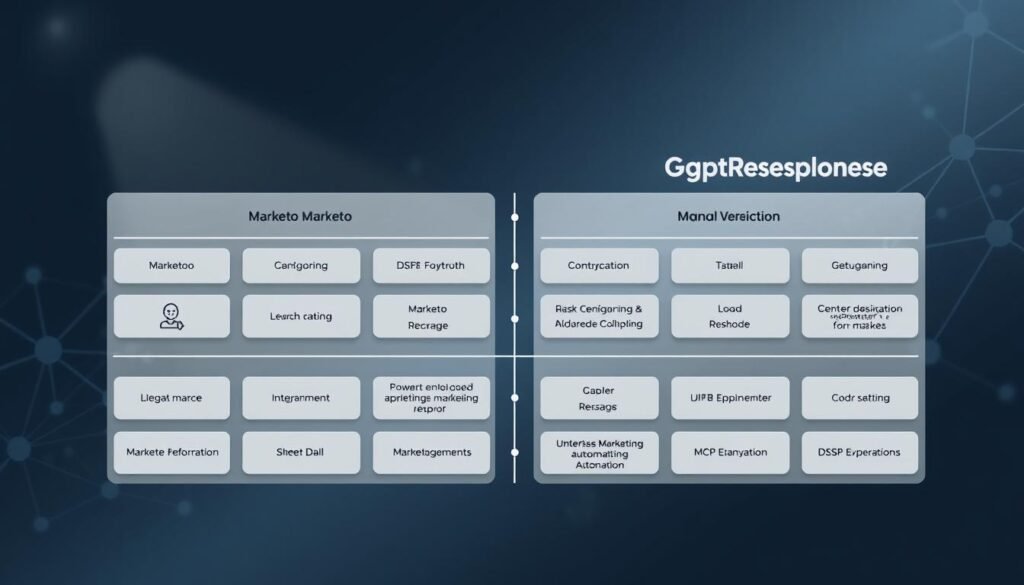Which platform truly saves your team time and delivers measurable marketing impact? You’re evaluating two major players and need a clear, data-led view fast. This intro orients you to core trade-offs between usability and depth.
Marketo targets enterprise-grade complexity with deep personalization and robust analytics tied to Adobe. GetResponse emphasizes an easy drag-and-drop experience, native webinars, and straightforward funnels.
You’ll see how each platform handles email marketing, automation, and integrations. We map features to real business needs so you can match tools to users and strategies. Expect practical notes on pricing, time to value, and common integration patterns like Salesforce or Shopify.
By the end, you’ll know which platform suits complex stack orchestration and which favors small medium-sized businesses seeking agility. This saves you early diligence time and points you to the right next steps.
Key Takeaways
- One tool favors depth and complex workflows; the other favors speed and usability.
- Check integrations and analytics alignment with your existing tech stack.
- Email marketing and funnels differ in setup time and required training.
- Review pricing models against expected contact volume and time to value.
- Match platform choice to the skills of your users and governance needs.
Enterprise marketing automation in 2025: what U.S. teams really need
U.S. marketing teams now demand systems that scale predictably while keeping audits and cross-team handoffs clean. You need tools that support growth without adding manual work or hidden risk.
Core priorities are scalability, compliance, and alignment between marketing, sales, and customer success. Automation must include role-based access, approval workflows, and audit logs so your processes stay reliable at scale.
Integration is nonnegotiable. Systems like CRM, analytics, and data warehouses must connect reliably. Look for observable pipelines, REST APIs or webhooks, and native connectors to cut maintenance load.
- When complex marketing needs include deep lead scoring and journey analytics, many large B2B teams choose tools that integrate with Salesforce or Microsoft Dynamics.
- When speed matters, small medium-sized businesses favor platforms that centralize funnels, landing pages, emails, and payments so campaigns launch fast.
Match features to team capacity and technology maturity. A powerful system that exceeds your level will slow work and drain resources. Map automation to measurable outcomes—pipeline velocity, influenced revenue, and lifecycle progression—so tools tie to business impact.
For real-world operational notes and complaints that affect procurement and rollout, see this review of implementation issues and common support patterns: platform review and complaints.
Feature comparison at a glance: robust depth vs streamlined essentials
This snapshot shows practical differences you’ll feel when building nurture paths and running campaigns. One platform focuses on multi-dimensional scoring, deep personalization, and analytics. The other centers on speed: drag-and-drop email and page builders, templates, and an integrated webinar experience.
Lead scoring and nurturing
Marketo supports multi-dimensional lead scoring—demographic fit, behavioral intensity, and recency—so you can prioritize and route leads with precision.
GetResponse offers basic scoring and practical nurture templates that reduce setup time. If your team needs quick wins, this approach lowers friction.
Email, pages, and funnels
The simpler platform delivers a drag-and-drop editor, many email templates, and landing pages that launch fast. It also includes native webinars and a Conversion Funnels flow that stitches pages, email, and payments together.
AI, personalization, and analytics
On the deeper side, AI-powered content recommendations and Adobe Experience Cloud tie-ins enhance cross-channel insights and experimentation. Those features drive stronger analytics but often need tighter governance and more configuration.
- Integration note: both platforms provide APIs and webhooks; one offers broader, more complex connectors, the other favors straightforward REST calls for common use cases.
- How to choose: pick the tool that matches your users’ skills—data-rich insights and segmentation favor depth; fast email, pages, and webinar launches favor streamlined design.
For user reports and hands-on feedback, see this community review that covers real-world setup and performance notes.
Recent updates that move the needle
The latest updates tilt the balance between deep insights and faster campaign launches. You now have clear trade-offs: advanced personalization and richer dashboards versus streamlined funnels and mobile execution.
Marketo: AI-driven content and richer dashboards
Marketo’s AI-powered content recommendations match assets to intent signals. That improves CTRs and lifts downstream conversion quality.
Enhanced dashboards deliver more customization and near-real-time metrics. Teams get faster insights into program performance and can act more quickly.
Deeper Adobe integration broadens journey analysis and attribution. This may require stricter governance and taxonomy work to keep data reliable.
GetResponse: funnels, triggers, and mobile gains
getresponse also offers Conversion Funnels that stitch landing pages, email sequences, and payments. That reduces handoffs and speeds go-to-market for lean teams.
Expanded automation triggers let you model nuanced lifecycle behaviors without heavy lift. The upgraded mobile app supports monitoring, broadcasts, and quick edits on the run.
- Impact: enterprise-grade insights vs faster time-to-launch.
- Practical note: advanced personalization may require extra data prep; simpler stacks deliver quick email marketing wins.
- Options: choose based on skills, data readiness, and desired growth pace.
Integrations and data flow for complex stacks
Connecting marketing systems to your core data stack is where most projects win—or stall. You need clear paths between CRM, commerce, and your warehouse to keep campaigns accurate and measurable.
CRM alignment: systems like Salesforce and Microsoft Dynamics
CRM alignment is pivotal. One platform provides robust, well-documented APIs and native connectors to crm systems like Salesforce and Microsoft Dynamics. That streamlines lead sync, MQL handoffs, and influence reporting.
Complex mappings may require field governance and technical support. Plan for schema reviews and mapping documents to avoid drift.
E-commerce and warehouse connectivity
For commerce, the simpler platform offers native integrations to Shopify and Magento that capture orders and abandoned carts with minimal custom work.
To operationalize audience definitions from your data warehouse, reverse ETL tools such as Census may be required. These tools push segments back into marketing systems so you can personalize at scale.
Seamless integration vs complexity: reducing rework and hidden IT load
Every connector increases maintenance. Favor managed integrations over one-off scripts to achieve a more seamless integration and reduce rework.
Build a monitoring process that tracks sync health, API limits, and failure alerts. This ensures integrations support marketing outcomes rather than creating ongoing support burdens.
- CRM: native connectors reduce custom work; complex bi-directional syncs may require advanced mapping.
- Commerce: native e-commerce hooks speed campaign activation for transactional events.
- Warehouse: reverse ETL fills gaps when native connectors can’t deliver the needed segmentation.
| Integration Layer | Strength | Typical Need |
|---|---|---|
| CRM (Salesforce/Microsoft Dynamics) | Native connectors, robust APIs | Lead sync, MQL handoff, campaign influence |
| E-commerce (Shopify/Magento) | Event-level native integrations | Orders, carts, transactional segments |
| Data Warehouse + Reverse ETL | Warehouse activation via tools like Census | Advanced segmentation, personalization enrichment |
User experience and learning curve for enterprise teams
How your team experiences a marketing platform shapes adoption and time-to-value. A clean UX speeds campaign launches. A cluttered UI lengthens setup and drains resources.
Steep learning vs quick rollout: how UX impacts time-to-value
Marketo is powerful but often demands specialist admins and process discipline. Its depth yields advanced segmentation and automation, yet the steep learning curve can delay results when your team lacks dedicated support.
GetResponse emphasizes templates, guided flows, and an intuitive editor. That design reduces onboarding time and helps users produce emails, pages, and webinars quickly with less reliance on experts. Additionally, the platform integrates seamlessly with various tools, allowing for a smoother user experience across different channels. Users can leverage GetResponse marketing automation features to create personalized campaigns, ensuring better engagement with their audience. This powerful combination of ease of use and advanced functionality makes it a valuable choice for businesses of all sizes.
- If your team is small or stretched, a steep learning tool can push out value and lower adoption.
- Map roles—admin, ops, creators—so features do not overwhelm users and momentum stays high.
- Pilot critical journeys first; add advanced automation as skills and governance mature.
- Track setup time versus execution time; if setup dominates, UX is slowing outcomes.
Recommendation: right-size your purchase to the team’s capacity. Invest in training and documentation where needed, but avoid feature overload that creates friction and wastes time.
Pricing and total cost of ownership

Pricing hides in plain sight: sticker rates show one number, but true cost includes training, customization, and ongoing maintenance.
Sticker price vs real cost: training, customization, and maintenance
One platform uses custom quotes that scale with database size and add-ons. That approach often means several thousand dollars per month and may require dedicated admin resources and specialist training.
The other offers tiered, contact-based plans starting near $15/month with higher tiers unlocking advanced automation, webinars, and team management.
Budget fit: custom quotes and tiered options
Model costs over 12–24 months. Include enablement, integration upkeep, and the time your team spends on data hygiene and reporting.
- Plan beyond sticker price: training, customization, and maintenance add materially to TCO.
- Predictability: tiered options make budgeting easier; custom quotes suit large, complex businesses.
- Time costs: integration projects and reporting can rival license fees in year one.
- Steep learning: a steep learning curve often drives extra training and support spend.
| Cost Element | Typical Impact | How to Budget |
|---|---|---|
| License / Subscription | Fixed or custom monthly fee | Use vendor quote + 10% contingency |
| Training & Enablement | One-time or recurring, varies with steep learning curve | Budget 1–3 months of internal resource time |
| Customization & Integrations | Initial build + ongoing maintenance | Estimate 6–12% of annual license cost |
| Support & Operations | Ongoing vendor or partner support | Include annual retainer or SLAs in forecast |
Best-fit scenarios and limitations
Assess each system by how it supports long, multi-touch B2B programs or fast SMB launches.
Marketo excels: complex B2B journeys, deep segmentation, data-rich analytics
Marketo is well suited to tech, healthcare, and financial services where complex marketing needs demand multi-stage journeys.
It supports advanced lead scoring, many segments, and tight CRM integration. This enables data-rich analytics and governance across long sales cycles.
GetResponse shines: SMBs, e-commerce funnels, and agile email programs
GetResponse fits small medium-sized businesses and commerce teams that need fast time-to-launch.
Conversion Funnels, abandoned cart hooks, native webinars, pages, and simple automation let lean teams run effective email marketing with fewer dependencies.
Where each may struggle: feature overload vs advanced enterprise needs
Marketo’s depth can feel like feature overload when teams only need basic campaigns. That steep learning curve raises training and support time.
Conversely, GetResponse may lack the reporting depth and some advanced features large companies require. Consider your ability to operationalize larger stacks before you commit.
- Use Marketo when long cycles, many segments, and attribution matter.
- Use GetResponse when speed, templates, and reliable execution matter most to a small team.
- Revisit fit annually as your business scales and data complexity grows.
getresponse vs marketo for enterprise: decision framework

Match your immediate campaign needs to each platform’s strengths before you budget for long-term custom work. Start by listing the processes that must run reliably day one—lead capture, CRM sync, and reporting. Use that list to score options against team capacity, budget, and time-to-value.
Evaluate by size, integration needs, and growth strategy
Size and systems matter. Large organizations needing deep CRM alignment with systems like Salesforce or Microsoft Dynamics should prioritize platforms with proven connectors and seamless integration patterns.
Smaller teams that favor fast launches and simpler stacks should prioritize tools that reduce custom code and speed deployment. Both setups can use reverse ETL to activate warehouse segments if needed.
Prioritize essentials over excess: align features to marketing outcomes
- Score integration needs: deep CRM sync vs simple event hooks.
- Map strategies to growth: new logo acquisition vs expansion motions.
- Define criteria: governance, SLAs, analytics depth, and cost to operate.
- Plan a phased roadmap and a simple RACI to protect ops and data ownership.
| Decision Area | Key Question | Action |
|---|---|---|
| Integration | Do systems like Salesforce need deep sync? | Pick proven connectors and add monitoring |
| Team | What level of admin support exists? | Right-size features to avoid brittle processes |
| Growth | Which strategies drive revenue? | Align automation to measurable outcomes |
Conclusion
Decide on the platform that matches your team’s skills and the measurable outcomes you must hit this quarter.
If your business faces complex marketing needs with strict attribution and deep CRM ties, Marketo suits advanced lead management, segmentation, and analytics.
When speed, predictable pricing, and fast email campaigns matter—particularly for small medium-sized businesses—getresponse accelerates launches with Conversion Funnels and native webinars.
Prioritize essentials: align automation and email investment to the campaigns you will actually run. Validate integration readiness early, especially around salesforce microsoft dynamics and crm systems like those.
Balance ambition with ability. Train users, limit unused features, and track build velocity and insights campaign performance so technology compounds results over time.

